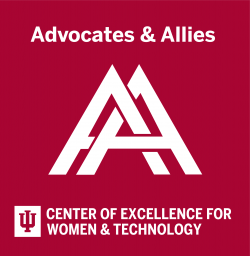This week’s tips are written to honor Autism Acceptance Month, examining the lived experiences of autistic people in higher education, particularly autistic students. We also focus in on how gender and other identities influence the expression and experiences of people diagnosed with autism spectrum disorder (ASD), and how we can create a more inclusive, accessible environment for neurodiversity.

Reflect: How does Ableism Intersect with Other Systems of Oppression?
ASD is diagnosed at higher rates in men, specifically white men, particularly when examining the age of diagnosis. Although some have argued for a biological cause for the difference in diagnosis rates, more recent data suggest that another explanation is the overrepresentation of white males in study samples, which in turn leads to reification of diagnostic criteria that are tailored to that group (Trubanova et al., 2014). Diagnosis is not required to identify with or to have a valid experience with autism; however, underrecognition of ASD in young adult women that leads to lack of or delayed diagnosis can have lasting negative impacts. For example, gender identity for women with autism can become complicated, because they may not express “typical” interests/behaviors that are associated with stereotypical gender roles, yet will still feel the overwhelming pressure to conform to sexist norms that are undergirded by ableism (Bargiela, Steward, & Mandy, 2016; Kanfiszer, Davies, & Collins, 2017). What are our stereotypical expectations based on sexism and ableism and how do they intersect? How do we respect the experiences, expressions, and perc
Learn: ASD and Ableism in Higher Education
The number of people diagnosed with ASD in higher education continues to grow. A significant barrier for people who are neurodivergent is the (un)conscious, negative beliefs of faculty, staff, and peers, which can include uncertainty around how to support them (Gibbons et al., 2015). While some educators may believe that they understand and support autistic students, traditional teaching methods have a narrow focus on what proper “learning” looks like, which excludes the learning styles of many neurodivergent students (von Below, Spaeth, & Horlin, 2021). Accommodations are an important pathway to alleviating this learning barrier; however, stigma around accommodations (including non-compliance) often prevent people from seeking them out (Lyman et al., 2016) and other factors influence the equitable access to accommodation (Waterfield & Whelan, 2017). Because of these negative experiences, autistic people in higher education can experience significant levels of mental health struggle (Van Hees, Moyson, & Roeyers, 2015).
Change:
- Adjusting your language around autism: Linguistic norms of the past often centered the level of function of someone with autism. However, not only is labeling someone a “high-functioning autistic” demeaning, this framing emphasizes how well an individual assimilates to expectations of able-bodied society rather than questioning whether our society is accessible to and inclusive of neurodivergent people (AutismBC, 2021). Furthermore, other out-dated terminology like categorical names for ASD such as “Asperger’s” lend continued credence to this same hierarchy of functioning. Other discourses around autism also use terminology like “special needs,” “suffering from,” and other negative language that positions autism as the problem in need of fixing, rather than the ableist expectations of society (Bottema-Beutel et al., 2021). Lastly, as with previous conversations about disability, one must respect that some people prefer identity-first (autistic person) over person-first labels (person on the autism spectrum), or vice versa. To show respect, our language must reflect the fact that people with ASD are complex, competent, and capable with their disability, not in spite of it.
- Make neurodivergence the norm: There are many ways that our daily lives can be made more inclusive of neurodiversity. In addition to enthusiastically embracing accommodations, faculty can incorporate assignment scaffolding, offer multiple modes of instruction, and establish a close relationship with disability services staff to ensure that they promote the success of autistic students and other neurodivergent students (Austin & Vallejo Peña, 2017; Sarrett, 2018). Similarly, departments/offices can minimize overstimulation by reducing background noise/visual clutter, establishing clear job duties (including incremental expectations for overarching projects and regular performance review), and opportunities for flexibility in completing tasks (e.g., working from home). Making spaces more inclusive of neurodiversity should be a proactive step, rather than just reactive to requests for accommodations.
- Creating meaningful relationships: One of the most prominent narratives that is put on people autistic individuals, from first-year students to staff and faculty, is that they lack the ability to be successful. Establishing meaningful relationships (including mentorship) where their agency/capability are recognized and emphasized consistently can dramatically counteract this narrative. These kinds of relationships are especially critical for women diagnosed with ASD (Webster & Garvis, 2017). In addition to helping shift self-perception, meaningful relationships can also support academic, social, and career-related skills, such as creating a buddy system with peers to attend social events or create new structures for study (Sarrett, 2018). When creating these relationships, it’s important to avoid creating a mindset of charity that can become incredibly patronizing and problematic.
Weekly Resource Recommendations
- Book: Neurotribes: The Legacy of Autism and the Future of Neurodiversity – Dr. Silberman discusses creating a culture where neurodiversity is not only accepted but celebrated.
- Video: Women and Autism. Toward a Better Understanding - Sarai Pahla discusses her life with autism and what we must do to recognize the intersection of race, gender, and neurodiversity.
- Article: Yes, That Too - Alyssa Hillary describes their experiences as an autistic person going through graduate school and their perspective on common discourses around autism.
- Podcast: Not Neurotypical - Laura Zdan explores her life after late diagnosis and the new ways she sees the world, as well as tips to support your neurodivergent loved ones.
Get these tips delivered to your mailbox!
We send these tips every Tuesday during the fall & spring semesters to our mailing list. If you are not already on our mailing list you can request to be added by completing the form below.

